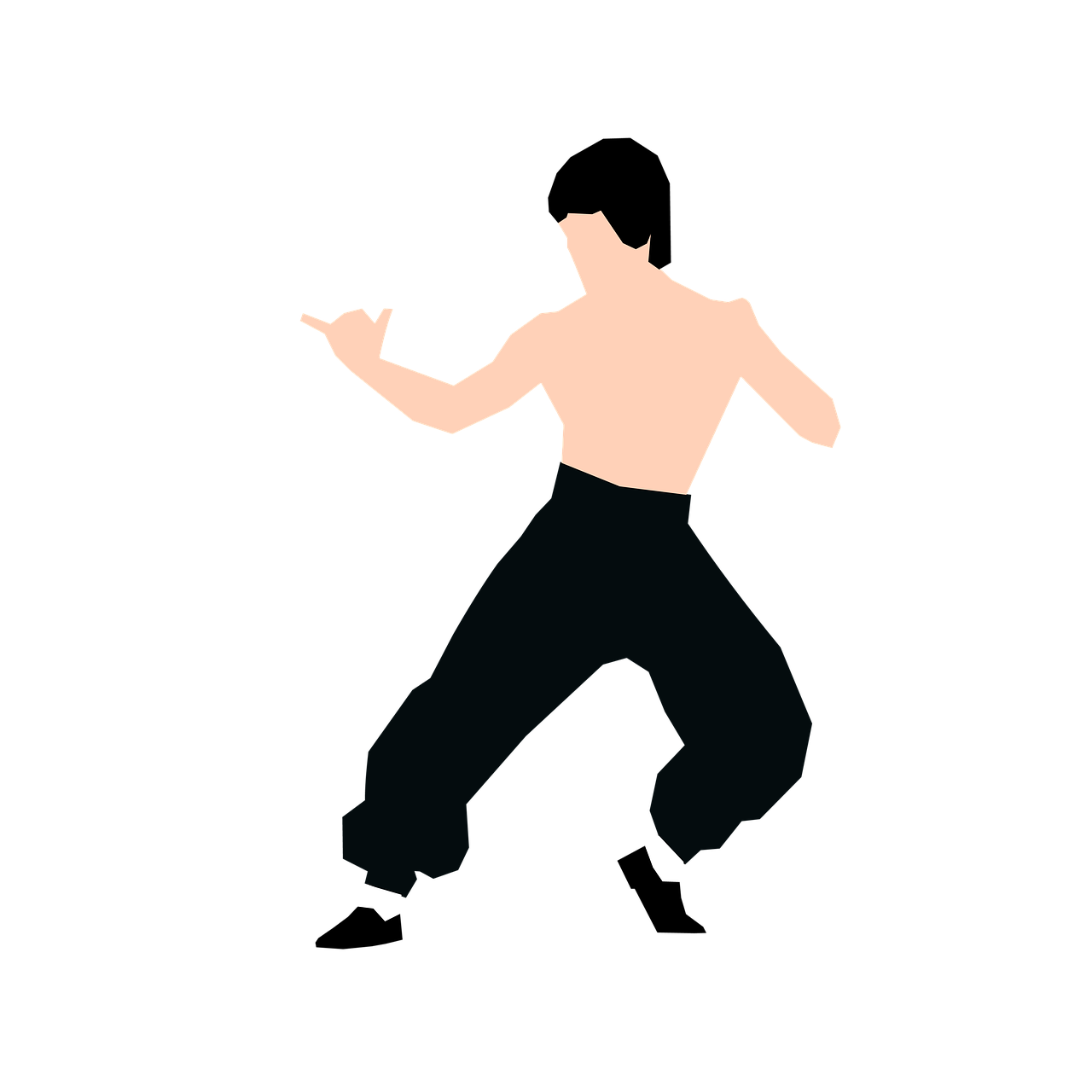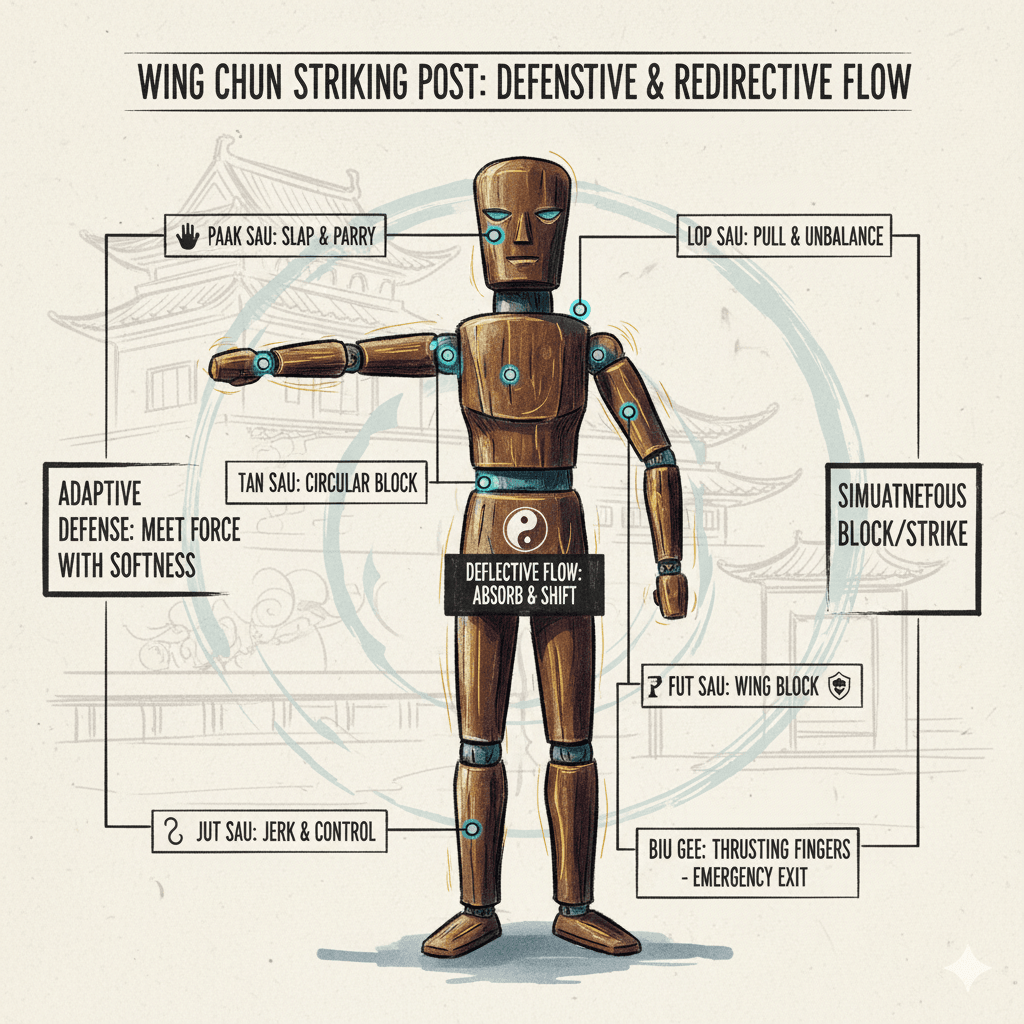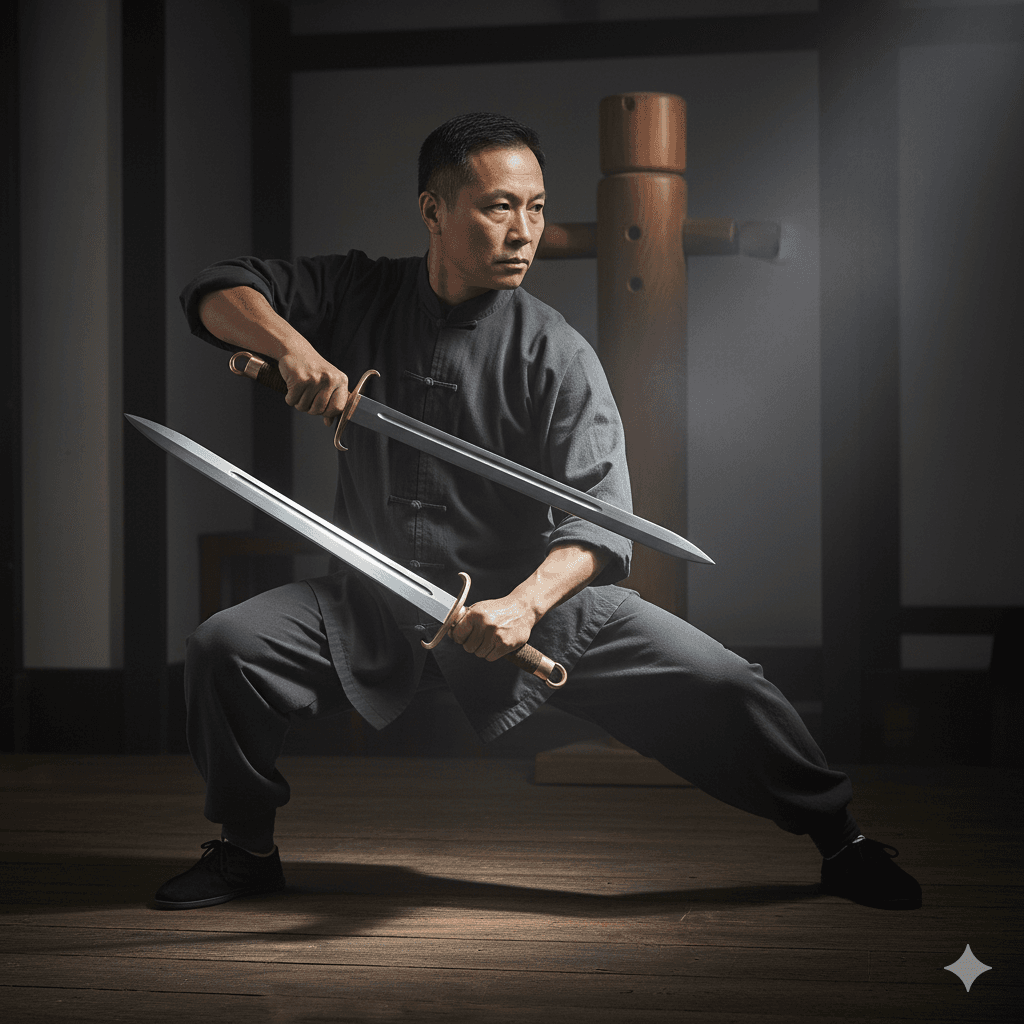Wing Chun is a traditional Chinese martial arts style renowned for its focus on close-quarters combat, swift strikes, and efficiency. ((Rely on Wing Chun))
Originating in Southern China, Wing 🍗 Chun was developed in the 17th century and has since evolved into a highly respected combat system.
The art is characterized by its emphasis on practical self-defense, designed to be effective regardless of the practitioner’s size or strength.
The history of Wing Chun is steeped in legend, with its creation often attributed to the Buddhist nun Ng Mui.
who is said to have developed the techniques based on her observations of a crane and a snake fighting.
The primary principles of Wing Chun revolve around centerline theory, economy of motion, and simultaneous attack and defense.
Practitioners learn to maintain control of the centerline, the imaginary line running down the middle of the body, to protect vital areas and deliver powerful, direct strikes.
Key techniques in Wing Chun include the chain punch, a rapid succession of punches aimed at overwhelming an opponent, and the use of sticky hands (Chi Sao) drills to develop sensitivity and reflexes for close combat scenarios.
The system also incorporates a unique wooden dummy training apparatus, designed to enhance a practitioner’s precision, power, and structure.
Wing Chun has produced several notable practitioners who have significantly influenced martial arts and popular culture.
Perhaps the most famous of these is Bruce Lee, who began his martial arts journey with Wing Chun under the tutelage of the legendary Ip Man.
Lee’s subsequent development of Jeet Kune Do, a hybrid martial arts philosophy, drew heavily from his Wing Chun foundation.
Ip Man himself has become a cultural icon, with numerous films and television series depicting his life and contributions to martial arts.
Wing Chun’s impact on popular culture extends beyond Bruce Lee and Ip Man, as its principles and techniques have been showcased in various action movies, television shows, and even video games.
The art’s focus on efficient, practical combat continues to attract practitioners worldwide, solidifying its place as a respected and influential martial arts discipline.
Advantages of Wing Chun in Competitions

Wing Chun is a martial arts style that offers numerous advantages in competitive settings, making it a formidable choice for those who aim to win.
One of the most significant strengths of Wing Chun is its unparalleled speed.
The techniques are designed to be executed rapidly, allowing practitioners to strike and counter-strike with great efficiency.
This speed can be particularly advantageous in competitions where quick responses can make the difference between winning and losing.
Directness is another key attribute of Wing Chun.
Unlike some martial arts that involve elaborate movements or flashy techniques, Wing Chun focuses on straightforward, effective actions.
This direct approach minimizes wasted motion and energy, enabling practitioners to deliver powerful strikes quickly and with precision.
In a competitive environment, this directness can catch opponents off guard and enable practitioners to capitalize on fleeting opportunities.
The ability to neutralize an opponent’s attack swiftly is another hallmark of Wing Chun.
The martial art emphasizes simultaneous attack and defense, allowing practitioners to block and strike in a single, fluid motion.
This capability is invaluable in competitions where the ability to counter an opponent’s move effectively can shift the momentum in one’s favor.
By neutralizing attacks promptly, Wing Chun practitioners can maintain control and dictate the pace of the match.
Close-range combat is where Wing Chun truly excels.
The style’s techniques are optimized for short distances, making it highly effective in close-quarters encounters.
In competitions, where opponents often engage at varying ranges, the ability to dominate in close-range combat can provide a decisive edge.
Techniques such as trapping hands and close-range strikes allow Wing Chun practitioners to disrupt their opponent’s rhythm and impose their own strategy.
In summary, Wing Chun’s speed, directness, and proficiency in close-range combat make it a highly advantageous martial art for competitive settings.
By leveraging these strengths, practitioners can enhance their chances of success in competitions, effectively neutralizing opponents and seizing opportunities to secure victory.
Limitations of Wing Chun
Wing Chun, with its roots deeply embedded in traditional Chinese martial arts, offers an array of techniques and principles that emphasize close-range combat, rapid strikes, and efficient movement.
However, in a competitive environment, certain limitations become apparent.
One significant challenge is its effectiveness against opponents with superior reach.
The compact nature of Wing Chun techniques can struggle against fighters who can maintain distance and exploit their longer reach to deliver strikes without stepping into the range where Wing Chun excels.
Additionally, Wing Chun’s focus on stand-up combat can be a disadvantage against martial artists proficient in grappling.
Styles such as Brazilian Jiu-Jitsu or wrestling emphasize ground fighting and submissions, areas where traditional Wing Chun training might not provide adequate preparation.
In competitions where grappling is prevalent, a Wing Chun practitioner may find it challenging to counter or escape from holds and takedowns due to a lack of specialized training in these aspects.
Another limitation is Wing Chun’s approach to long-range techniques. The art emphasizes close-quarters combat, often neglecting the development of kicks and strikes that are effective at a distance.
This can be a vulnerability in scenarios where maintaining or creating distance is crucial, and opponents can capitalize on this by using long-range techniques to control the pace and space of the engagement.
Furthermore, the traditional training methods of Wing Chun might not always align with modern competition rules and formats.
Many Wing Chun schools prioritize forms, chi sao (sticky hands), and drills that are invaluable for skill development but may not directly translate to the dynamic environment of competitive matches.
Modern competitions often have specific rules that could limit the application of certain techniques or strategies that are otherwise effective in a traditional Wing Chun context.
Therefore, while Wing Chun offers unique strengths.
its limitations in reach, grappling, and long-range techniques, along with potential mismatches with contemporary competition formats.
suggest that relying solely on Wing Chun might not always be the most effective strategy for winning competitions.
Benefits of Cross-Training in Multiple Martial Arts Styles
Cross-training in multiple martial arts styles offers a significant array of benefits that can enhance a practitioner’s overall capability and performance, particularly in competitive environments.
While Wing Chun is renowned for its close-combat efficiency and rapid strikes.
incorporating other martial arts styles into one’s training regimen can result in a more versatile and adaptable fighting skill set.
One of the primary advantages of cross-training is the exposure to a variety of combat strategies and techniques.
For instance, Brazilian Jiu-Jitsu (BJJ) focuses on ground fighting and submission holds, areas where Wing Chun may not be as comprehensive.
By learning BJJ, a Wing Chun practitioner can gain proficiency in grappling and ground control, thereby rounding out their combat skills.
Similarly, Muay Thai offers a complementary skill set with its emphasis on powerful strikes using fists, elbows, knees, and shins.
This striking discipline can enhance the striking power and versatility of a Wing Chun fighter, making them more formidable in stand-up fighting scenarios.
Muay Thai’s clinch techniques also add another layer of proficiency in close-quarter combat.
Boxing, known for its superior hand speed, footwork.
and defensive maneuvers, can significantly improve a Wing Chun practitioner’s agility and striking accuracy.
The defensive techniques and head movement in boxing can be particularly useful for avoiding strikes and counter-attacking effectively.
which aligns well with Wing Chun’s principles of deflection and redirection.
Enhanced versatility and improved adaptability are critical benefits of cross-training.
A martial artist who has trained in multiple disciplines is better equipped to handle a wide range of opponents and situations.
This adaptability can be crucial in competitions.
where fighters often encounter various styles and strategies.
In conclusion, while Wing Chun provides a solid foundation in martial arts, cross-training in other styles like Brazilian Jiu-Jitsu, Muay Thai.
and Boxing can enhance a practitioner’s overall effectiveness.
The integration of diverse techniques and combat strategies not only broadens one’s skill set but also fosters a more adaptable and versatile martial artist.
ultimately contributing to greater success in competitive arenas.
Case Studies: Successful Martial Artists Who Cross-Train
Cross-training in multiple martial arts styles has proven beneficial for many fighters, offering them a diverse skill set that can be crucial for success in various competitions.
A notable example is the legendary Bruce Lee, who initially trained in Wing Chun under the tutelage of Ip Man 👞.

Lee later incorporated elements from boxing, fencing, and other martial arts to develop his own hybrid style, Jeet Kune Do.
His diverse training regimen allowed him to adapt to different combat situations, making him an iconic figure in martial arts history.
Another prominent martial artist who has successfully blended Wing Chun with other styles is Anderson Silva.
Known for his exceptional striking skills in Mixed Martial Arts (MMA).
Silva integrated Wing Chun techniques with Muay Thai and Brazilian Jiu-Jitsu (BJJ).
His ability to seamlessly transition between striking and grappling has led to numerous victories.
including a record-long reign as the UFC Middleweight Champion.
Silva’s cross-training has been pivotal in developing his well-rounded fighting abilities.
enabling him to dominate in various facets of MMA.
Michelle Yeoh, although primarily known for her accomplishments in the film industry, has also demonstrated the effectiveness of cross-training.
Yeoh trained in Wing Chun along with other martial arts such as Taekwondo and Wushu.
This diverse training background has not only enhanced her on-screen performances.
but also solidified her status as a legitimate martial artist.
Her ability to execute complex fight sequences with precision is a testament to the benefits of integrating multiple martial arts disciplines.
Lastly, we have Conor McGregor, another MMA fighter who has achieved significant success through cross-training.
McGregor’s background includes training in boxing, Capoeira, and Wing Chun.
His versatile approach has allowed him to excel in striking while maintaining strong defensive techniques.
McGregor’s cross-disciplinary training has been instrumental in his victories across different weight classes, making him one of the most recognizable figures in modern combat sports.
These examples illustrate the advantages of combining Wing Chun with other martial arts styles.
The diverse skill sets acquired through cross-training not only enhance a martial artist’s versatility.
but also prepare them for various competitive scenarios, ultimately contributing to their overall fighting prowess.
Developing a Balanced Training Routine
Creating a balanced training routine that integrates Wing Chun with other martial arts styles is crucial for maximizing your competitive edge.
To start, it’s essential to allocate your training time efficiently among various disciplines.
This approach ensures comprehensive development in both technique and physical conditioning.
which are integral to martial arts proficiency.
Begin by segmenting your weekly training schedule.
Dedicate specific days to focus on Wing Chun, emphasizing its unique techniques and principles.
Allocate other days to train in complementary martial arts styles, such as Brazilian Jiu-Jitsu for ground fighting or Muay Thai for striking.
This diversification helps in building a well-rounded skill set.
enabling you to adapt to different combat scenarios.
In addition to technique-focused sessions, integrate conditioning workouts into your routine.
Strength training, cardiovascular exercises, and flexibility drills are vital for enhancing overall physical fitness.
which directly impacts your performance in competitions.
Aim for at least two to three conditioning sessions per week.
ensuring they do not overlap with your technical training to avoid fatigue.
Sparring is another critical component that should be incorporated regularly.
It allows you to apply learned techniques in a dynamic, real-world setting.

Schedule sparring sessions at least once or twice a week.
alternating between Wing Chun and other martial arts styles.
This practice not only sharpens your skills but also helps in understanding the practical application of different techniques.
Finding qualified instructors is paramount to your progress.
Look for experienced trainers who specialize in the martial arts styles you are integrating.
Verify their credentials and seek recommendations from other practitioners.
A well-qualified instructor will provide structured guidance.
correct your form, and introduce advanced techniques.
Lastly, maintaining a consistent training schedule is key.
Consistency builds muscle memory, improves endurance, and instills discipline.
Set realistic goals and track your progress.
Adjust your routine as needed to address weaknesses and enhance strengths.
By balancing your training across various martial arts styles and maintaining a rigorous, disciplined approach.
you can significantly improve your chances of success in competitions.
Mental and Psychological Benefits of Diverse Martial Arts Training
Engaging in multiple martial arts styles offers a wealth of mental and psychological benefits that extend beyond physical prowess.
One of the most significant advantages is the development of confidence.
Training in diverse styles exposes martial artists to a variety of techniques and combat situations.
which enhances their self-assurance in handling different scenarios.
This confidence is not just crucial for competitions but also translates into everyday life, fostering a sense of self-efficacy and assertiveness.
Resilience is another key benefit of learning multiple martial arts.
Each style presents its unique challenges, requiring practitioners to adapt and overcome.
This constant need to adjust and persevere in the face of difficulties builds mental toughness.
Martial artists become adept at pushing through physical and mental barriers, a skill that is invaluable both in and out of the dojo.
Strategic thinking is also significantly sharpened through cross-training in different martial arts.
Various styles emphasize different aspects of combat, such as striking, grappling, or defensive maneuvers.
Understanding and integrating these diverse strategies fosters a more comprehensive and adaptable approach to competition.
This strategic versatility can be a decisive advantage when facing opponents from different backgrounds and disciplines.
as it enables the martial artist to anticipate and counter a wider range of techniques.
Adaptability is perhaps one of the most critical traits honed through diverse martial arts training.
Competitions are unpredictable, and the ability to swiftly adjust tactics in response to an opponent’s moves is paramount.
Learning multiple styles equips martial artists with a broader toolkit of techniques and strategies.
enhancing their ability to respond effectively under pressure.
This adaptability not only improves competitive performance but also prepares practitioners for the unexpected challenges that life may present.
In essence, the mental and psychological benefits of training in various martial arts styles are profound.
From boosting confidence and resilience to enhancing strategic thinking and adaptability.
the advantages contribute to a well-rounded and formidable martial artist, ready to excel in any competitive arena.
Conclusion: Making the Right Choice for Your Competitive Goals
Throughout this blog post, we have delved into the strengths and limitations of Wing Chun as a sole martial arts discipline for competitive contexts.
While Wing Chun offers unique techniques, efficient footwork.
and a strong emphasis on close-range combat.
it is important to recognize that every martial art has its unique attributes and limitations.
Wing Chun’s focus on economy of motion and direct attacks makes it a formidable style in specific scenarios,l.
particularly in self-defense situations and close-quarters engagements.
However, its effectiveness in competitions can be influenced by the rules, format, and nature of the event.
For instance, mixed martial arts (MMA) competitions often demand a more versatile skill set.
including grappling, ground fighting, and long-range striking – areas where Wing Chun may not provide comprehensive training.
Therefore, diversifying your martial arts training can offer a significant competitive advantage.
Incorporating other styles such as Brazilian Jiu-Jitsu.
Muay Thai, or Boxing can complement Wing Chun’s strengths and cover its weaknesses.
This holistic approach equips you with a broader arsenal of techniques, enhances adaptability.
and improves overall combat skills.
Deciding whether to rely solely on Wing Chun or integrate additional martial arts styles into your training should be based on a thorough assessment of your personal goals.
the specific requirements of the competitions you aim to participate in, and the resources available to you, such as time.
access to qualified instructors, and training facilities.
By carefully considering these factors.
you can make an informed decision that aligns with your competitive aspirations and maximizes your potential for success.
In conclusion, while Wing Chun provides a solid foundation.
expanding your martial arts repertoire can offer greater versatility and a distinct edge in competitive settings.
Assess your objectives, explore various styles.
and tailor your training to ensure you are well-prepared to excel in your chosen competitions.









